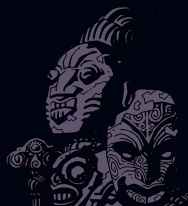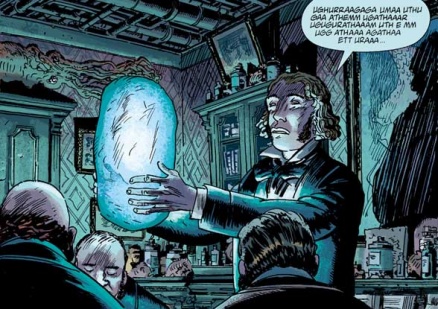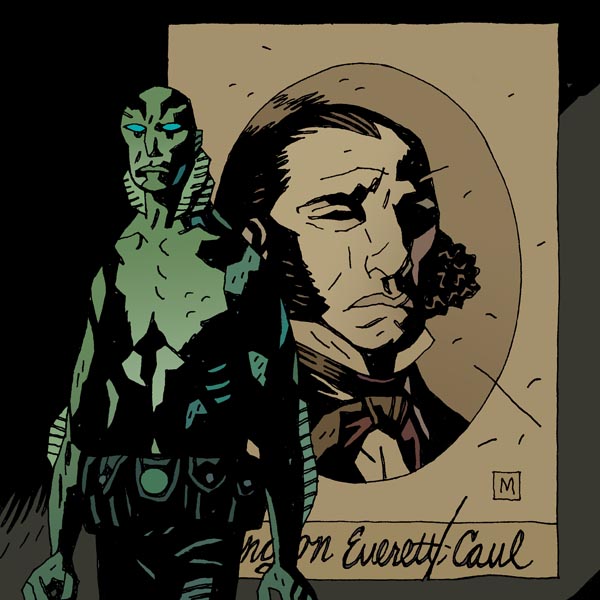
Here it is, the first Hell Notes of 2015. If you’re new to Hell Notes, this column is where Mignolaversity takes a deeper look at various elements of the Hellboy Universe (and occasionally Mignola’s other universes, such as Baltimore).
This year I’m planning to tackle Abe Sapien. I say “this year” and not “this month” because it’s going to be a three-part article, starting with this one. Back in March last year I tackled a three-part column on Hellboy for the 20th anniversary of the comic. It was a lot of fun, but also extremely demanding. It’s not something I intend to ever repeat. But Abe has too much history to be a single article. I just couldn’t do him justice. So the plan is to space it out over the next six months with each part dealing with a different phase of his life.
Welcome to phase one: Langdon Everett Caul. This particular phase of Abe’s life is still largely a mystery to readers and to Abe himself. And to me! For this column I had to lean on material from the Hellboy Companion more than I usually do (in particular the work of Victoria Blake and Rachel Edidin), and on the expertise of Abe Sapien writer, Scott Allie. Thanks for your help!
OK, let’s get to it…
Spoiler Warning. If you’re roughly up to date, there won’t be any major spoilers, but if you’re fussy about this sort of thing, make sure you’ve read up to Abe Sapien #19. I also recommend reading Abe Sapien: The Calm Before the Storm, from Alise Gluškova, Scott Allie, and Clem Robins, which premiered on this site earlier today.

Caul’s father however wasn’t so enthusiastic. In fact, he thought there was something wrong with his youngest son, and decided he needed to teach the boy what it was to be a real man. In 1810, at the age of twelve, he sent Caul away on one of his ships, hoping that the harsh life at sea would knock this nonsense out of him and make him more like his brothers.
Caul never forgave his father for this, but in its own way this actually worked out for him. Caul loved life on the sea, and the Captain he sailed under, Edward Henry, treated the boy like his own son. He indulged his interests, and during the off-season Caul stayed with Captain Henry and his wife, poring over books that set his curious mind ablaze. With the Henries not only was Caul allowed to be himself, he was encouraged and nurtured to the best of their capability.
For five years Caul lived this way, but at last he returned home. Things had changed while he’d been away. Two of his brothers had died, and the other had lost his leg to gangrene. Suddenly Caul was no longer the useless son in his father’s eyes. He had become his most able-bodied heir, the one he wanted to take on the family business. But Caul had no interest in his father’s wishes. He had fallen in love with the sea, and he wanted to be free to pursue his scientific interests wherever they should lead.

Caul made a point of never involving himself in such rumours. He respected Captain Cavendish’s privacy, and in turn this gained him what little trust a man of Captain Cavendish’s calibre could muster. Caul rose rapidly from deckhand to the Captain’s personal secretary, a job that got him closer to the truth than any rumours among the crew would have. The Captain would get very drunk, and in his intoxicated state, he would tell Caul all manner of incredible tales of his adventures at sea.

Caul had no way of knowing it, but Captain Cavendish was right, at least in the broad details. “The Golden People” had once lived on the continent of Hyperborea before it was overtaken by Polarian Ice. Captain Cavendish believed their secrets still lay hidden somewhere in the Arctic, waiting to be found. The stories were unbelievable, but they captured Caul’s fascination.
When Captain Cavendish sobered up, he realised he had revealed far more than he intended and became distant, but Caul’s curiosity was far from sated. Quite the opposite, he became obsessed with idea of a prehuman race, so much so that his dreams were filled with their lost cities. When Caul asked questions about the story, Captain Cavendish became evasive, and he became increasingly worried about Caul’s interest in the Hyperboreans. At the height of his paranoia he even falsely accused Caul of breaking into his cabin and snooping around. By June, Caul had had enough of being under constant suspicion, and so he left the ship when it docked at its next port.
Caul was thirty-four when he finally stopped travelling for a time and stayed put in London. But he didn’t make a home there. This was time he devoted to furthering his studies. He befriended several scientists to challenge his intellectual development. Caul found the idea of evolution compelling, particularly the notion that all life on Earth came not from a lofty deity, but from the humble oceans.
In 1834, Caul’s studies caught the attention of Dr. Norman Netaunt, an elder of the Oannes Society, an off-shoot of the much more prominent Heliopic Brotherhood of Ra.4 These two societies were public knowledge in those days, a natural part of life for those at the forefront of the modern world.

In the July of that year, Caul was invited to one of their meetings where he was told in greater detail about Oannes, the mythological figure for which their society was named. Oannes was a man from the waist up, with the tail of a fish, and it was he that had taught wisdom to the Babylonians. The Oannes Society believed he was more than a mere fish-man though. They thought he was an “Ancient,” what we’d probably call a Hyperborean, though I don’t know if the Oannes Society considered these two terms to be interchangeable. They probably did though. What I do know is that they believed human kind descended from Oannes and his merfolk kind.
Continued belowIs there any truth in this? I honestly can’t say. Humans certainly evolved from an ape-like species in the Hellboy universe, perhaps even several. Could there also be a dash of merfolk in there too? Or is this one of the more fanciful aspects of the Oannes Society’s beliefs? I am reasonably sure though that Oannes (or Dagon as he is also known) did exist in some form though. He has appeared in artwork of various societies, and ancient cultures that existed long before even the earliest forms of humanity know the name Dagon and associate it with some manner of amphibious man.
The Oannes Society believed many things that would be frowned upon by the common people, but Caul was enamoured by it all. Here, at last, he felt he had found like-minded people. Two months later he was officially initiated into the Oannes Society and he quickly became a prominent figure amongst them. He became particularly close with three members: Mr. Phillip Ensner, Mr. Dameron, and Mr. McWhirter. These three looked up to Caul and considered him their unofficial leader.

Then, in 1845, Caul’s father died. Had there not been such contention between him and his father this would have been a sad and difficult time for Caul. Instead, this was the source of greater fulfilment. Caul’s father left his entire estate to his youngest son. Caul promptly sold off the family business and all other assets, and donated virtually all the money from the sale to the Oannes Society. His father’s death gave him the chance to further a cause he believed in.
And his money and connections in America were of considerable value to the Oannes Society. In April, 1853, Caul set to work establishing a base of operations for the Oannes Society in his homeland. Over the next eight years he oversaw the construction of a mansion in Littleport, Rhode Island. It was of some curiosity to the locals, for most of the construction was handled by foreigners, mostly French workers, and Caul insisted on some rather peculiar architectural features. The locals had no way of knowing, of course, that the plans for this building had been drawn up in the Paris headquarters of the Oannes Society.

Here’s the weird thing, though. At this point in time Caul was in fifties, though he certainly didn’t look it. How this is possible remains an unanswered mystery. Perhaps some time between 1834 and 1853 he had found a way to halt the ageing process. Thing is, this is hardly a unique occurrence. Throughout Mignola’s books, there have been several people from the Heliopic Brotherhood of Ra or its splinter organisations that seem to have been able to halt the ageing process. In fact quite a few, now that I think of it.
However, Caul’s companions, Ensner, Dameron, and McWhirter, did not seem to share his youthfulness. By the 1850s they had already physically aged beyond their companion, and in the 2000s they had become entirely reliant on cyborg bodies to keep them alive… but that’s a topic for the next Abe Sapien article. All we need to know for now is that these guys were deteriorating with age and apparently Caul was not.
On the 24th of November, 1859, Caul was invited to the unravelling of an Egyptian mummy at the home of Lord Minnbrough in London. This was possibly the one of the last times he would visit London, as the American Civil War was making these trips difficult for him. It was here that Caul met the last addition to his inner circle, Mr. Edward Musgrove Sundborne.

Sundborne was a relatively new member of the Oannes Society, and while he had worked with Ensner, Dameron, and McWhirter, he had never had the opportunity to meet Caul, though he had heard a great deal about him and admired him fiercely.
Continued belowCaul also had his first encounter with another person that would play a significant role in his life, though they wouldn’t properly meet until well over a century later. I’m talking, of course, about the mummy.

But Panya was of little interest to them at the time. Caul and his inner circle had schemes of their own. They believed that the end of the world was coming, and they wanted to be prepared for it. They didn’t think they could stop it though, so they focused their energies on surviving it. They planned to create what they called “spiritual reservoirs,” impressive, genetically superior human bodies filled with thousands upon thousands of humans souls. I don’t know how far Caul worked this plan out with his companions, for he was only involved at the earliest stages, but his ideas were the core of it.
In 1861 Caul’s mansion in Littleport was finally completed, so he decided to marry. I don’t think he was ever in love though. It seems to me he got married because that was the thing to do now that he had settled somewhere. This decision was one that excited the locals though. Caul may have been eccentric, but he was also wealthy, and he may have been sixty-two, but he looked like a man half his age. In short, he was a desirable catch, and that March he married a young woman called Edith Howard.

Caul should have been sensitive to his wife’s needs, but he was on the cusp of a voyage quite unlike anything that had ever been attempted. With his submersible complete, he hoped to find the merfolk descendants of Oannes. He believed the Oannes Society had located Atlantis, and would not be swayed from this voyage, not even for the health of his wife.
Edith did not understand why her husband wanted to leave. She knew it was for his scientific studies, but he’d never told her more than that. As the date of his departure came closer, Edith fought with him, begging him to stay. She had convinced herself that if he left, he would never come back. Caul promised her he would return, and that when he did, he would never leave again. However, he insisted on this last voyage. I don’t know that he ever intended to keep his promise, and even if he did, I doubt he would have had the capacity to hold to it. His work was clearly more important to him.
Not that it mattered either way in the end. On the 22nd of February, 1865, Caul left Littleport and was never seen there again. Edith waited for him, and with each passing day she grew more and more distraught. During a storm less than a month later, Edith threw herself off a cliff into the raging sea. Her body was never recovered.

As for Caul, he and his companions had, with the help of a German psychic, located the ruins of Atlantis just as they had thought. On a deep-sea dive, Caul found an egg-like artefact and brought it back to one of the Oannes Society’s secret laboratories in a sub-basement of Saint Trinian’s Hospital in Washington, D.C.
Continued below
I can only imagine what they thought the egg was, but they knew there was some entity within it, and on the 9th of April, Caul and his four companions attempted to make contact with it. The five men put themselves into a trance state, and Caul allowed himself to be temporarily possessed by the entity. Then something disrupted the process. Abruptly, the others awoke from their trace state, and the egg in Caul’s hands crumbled to dust. At the door, Caul saw an apparition, an amphibious man in the room with them, though none of his companions could see it.
The apparition approached Caul without saying a word. For some reason, Caul decided the creature had come for him because of something he’d done, and he warned his companions to save themselves and not to pursue the matter any further. He made an attempt to talk to the spirit one last time, but when it touched him, he fell to the floor, unconscious.
And then he began to change into an amphibious man, just like the apparition he had seen.
Caul’s companions put him in a tank of water and studied his transformation closely. They were not distressed by what was happening to their friend. Quite the contrary, they celebrated. They believed Caul had found the spirit of Oannes, and his change was into something greater than he had been before.

They did not celebrate for long though. On the 14th, the actor John Wilkes Booth murdered President Lincoln at Ford’s Theatre. The Oannes Society, fearing that John Wilkes, or his co-conspirator David Herold, would reveal their connection to the assassination, decided to flee America. On the 2nd of May, Caul’s companions sealed up the hidden laboratory in Saint Trinian’s Hospital, promising to return for him some day. Caul was left in the dark inside his sub-basement tank, and there he stayed sleeping for a hundred and thirteen years and six months.
When Caul was finally awoken, it was not the Oannes Society that had found him, but another organisation altogether…

And so ends the first phase of Abe Sapien’s life. I still have a lot of questions about this period though. How did Abe survive in the tank for so long? Was this part of Caul’s unnatural youth at work? Or was it part of the function of the tank he was in? Or was his new body ageless? And what had Langdon Caul done that made him believe the spirit had come for him and that it wished him ill?
Captain Cavendish apparently had many adventures, and Caul sailed under his command for sixteen years. Surely Caul had been a part of some of those himself. Did Caul ever later realise the significance of some of those trips and return there later in life when he was a part of Oannes?

Surely there must be a connection between these two? I wonder…
1Captain Elihu Cavendish: This guy set the wheels in motion for some big things. His plight to find the Hyperborean ruins in the Arctic became a family obsession carried on for generations after his death. The Cavendishes finally found them in 1993, which led to the disastrous events of Hellboy: Seed of Destruction.
2Ogdru Hem: You know the big rampaging monsters in B.P.R.D. Hell on Earth? Well, they weren’t always rampaging. In fact, they’ve spent a very long time buried in the earth.
3Hyperboreans: “The Golden People,” the first race of man.
4The Heliopic Brotherhood of Ra: The ultimate secret society in the Hellboy Universe. These guys, or some off-shoot of them, keep popping up everywhere. I will be writing a Hell Notes column about these guys eventually…






